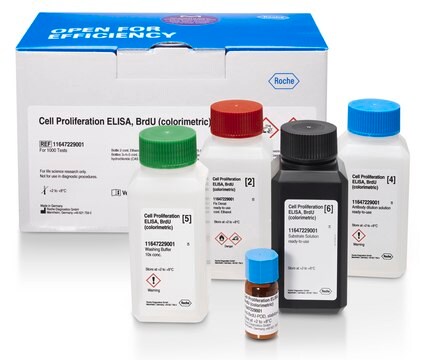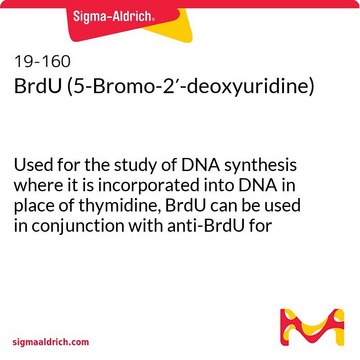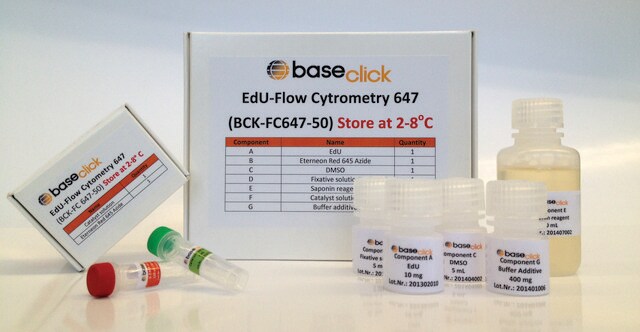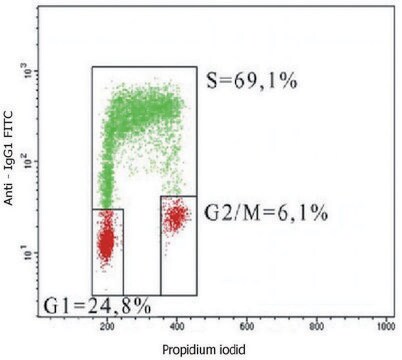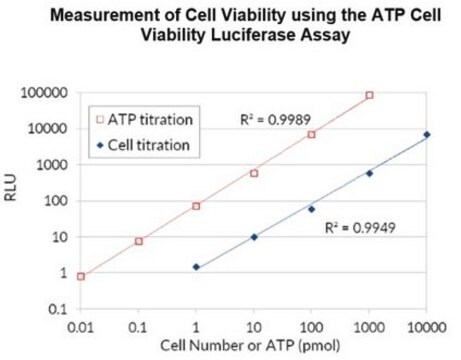11299964001
Roche
5-Bromo-2′-deoxy-uridine Labeling and Detection Kit II
sufficient for ≤100 tests, storage temp.:-20°C
Sinônimo(s):
5-BrdU, 5-Bromo-2-deoxyuridine
About This Item
Produtos recomendados
Nível de qualidade
uso
sufficient for ≤100 tests
fabricante/nome comercial
Roche
temperatura de armazenamento
−20°C
Descrição geral
Alternatively, 5-bromo-2′-deoxy-uridine (BrdU) may be used instead of thymidine. Cells that have incorporated BrdU into DNA are easily detected using a monoclonal antibody against BrdU and an enzyme- or fluorochrome-conjugated second antibody.
Especificidade
Aplicação
- labeling of tooth roots for histology
- immunostaining of mice frontal sections
- immunofluorescence imaging of hepatocellular carcinoma sections
Características e benefícios
- Safe: No radioisotopes are used.
- Easy to perform: Follows a standard immunohistochemistry protocol.
- Sensitive: Denaturation of DNA with nucleases allows for highly sensitive detection of BrdU.
- Flexible: Allows double-labeling protocols.
Embalagem
Princípio
Nota de preparo
Sample material:
Cell culture: adherent cells, suspension cells, organ or explant cultures. Frozen or paraffin-embedded tissue sections (after in vivo labeling).
Outras notas
Somente componentes do kit
- BrdU Labeling Reagent 1,000x concentrated
- Washing Buffer concentrate 10x concentrated
- Incubation Buffer
- Anti-BrdU antibody, contains nucleases for DNA denaturation
- Anti-mouse Ig-alkaline Phosphatase antibody
- NBT
- BCIP
Palavra indicadora
Danger
Frases de perigo
Declarações de precaução
Classificações de perigo
Acute Tox. 4 - Acute Tox. 4 Inhalation - Eye Irrit. 2 - Flam. Liq. 3 Dermal - Muta. 1B - Repr. 1B - Skin Sens. 1
Código de classe de armazenamento
3 - Flammable liquids
Classe de risco de água (WGK)
WGK 2
Ponto de fulgor (°F)
136.4 °F
Ponto de fulgor (°C)
58 °C
Certificados de análise (COA)
Busque Certificados de análise (COA) digitando o Número do Lote do produto. Os números de lote e remessa podem ser encontrados no rótulo de um produto após a palavra “Lot” ou “Batch”.
Já possui este produto?
Encontre a documentação dos produtos que você adquiriu recentemente na biblioteca de documentos.
Os clientes também visualizaram
Artigos
Cell based assays for cell proliferation (BrdU, MTT, WST1), cell viability and cytotoxicity experiments for applications in cancer, neuroscience and stem cell research.
Nossa equipe de cientistas tem experiência em todas as áreas de pesquisa, incluindo Life Sciences, ciência de materiais, síntese química, cromatografia, química analítica e muitas outras.
Entre em contato com a assistência técnica
